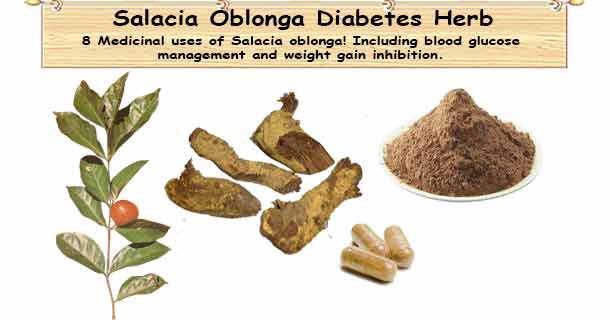Salacia oblonga may help manae blood-glucose, and it has an additional benefit of weight gain inhibition.
What is Salacia Oblonga?
Salacia oblonga plant: Salacia oblonga is a woody plant native to Sri Lanka and India. The roots and stems of Salacia oblonga are in use extensively in Ayurveda and Traditional Indian Medicine for different medical conditions, including diabetes.
{"preview_thumbnail":"/drupal8/sites/default/files/styles/video_embed_wysiwyg_preview/public/video_thumbnails/QkoXQIt6Y2I.jpg?itok=MpcyyNVa","video_url":"https://youtu.be/QkoXQIt6Y2I","settings":{"responsive":1,"width":"854","height":"480","autoplay":0},"settings_summary":["Embedded Video (Responsive)."]}
Salacia herb help lower blood sugar level
Co-administration of conventional drug and herbal medicine may cause potential interactions that lead to adverse events. So get doctor’s consent before starting herbal treatment.
Salacia oblonga binds to intestinal enzyme alpha-glucosidases that break down carbohydrates into glucose in the body. Thus, less glucose gets into the bloodstream, resulting in lower blood glucose.
Scientific evidence for the diabetes herb Salacia oblonga
- The study result show, the extract of Salacia oblonga lowers acute glycemia and insulinemia in persons with type 2 diabetes after a high-carbohydrate meal. Extract of Salacia oblonga lowers acute glycemia in patients with type 2 diabetes. American Journal of Clinical Nutrition 2007 Jul;86(1):124-130.
- Salacia Extract Improves Postprandial Glucose and Insulin Response in Healthy Volunteers. Journal of Diabetes Research, Volume 2016, Article ID 7971831, 9 pages.
- Salacia root, a unique Ayurvedic medicine, meets multiple targets in diabetes and obesity. Life Sciences, Volume 82, Issues 21–22, 23 May 2008, Pages 1045-1049.
Unlike conventional drugs, herbal medicines are complex mixtures of bioactive compounds. Season, growing condition, processing method can vary the constitutions of the bioactive compound.
8 Medicinal uses of Salacia oblonga
Salacia Oblonga is consider to possess anti-diabetic agent. Traditionally, it is in use for blood-glucose management, effective for type 2 diabetes management and also beneficial for type 1 diabetes.
For a test meal, the blood glucose level drop by about 23 % in non-diabetic human subjects given 1 gram of Salacia oblonga extracts with the test meal, according to a study in the January 2005 issue of the “Journal of the American Dietetic Association.”
- Improves blood sugar - Salacia oblonga inhibits carbohydrate absorption, increase the efficiency of insulin action, decrease postprandial insulin, increases tissue glucose sensitivity, decrease in blood glucose, and decrease HbA1c.
- Cholesterol control - S oblonga has lipid-lowering and anti-inflammatory effects. It is capable of improving lipid profiles and systemic inflammation in diabetics. It lowers serum cholesterol, triglycerides, and increasing HDL cholesterol levels.
- Kidney tonic - Oblonga stabilizes kidney function both in diabetics and nondiabetics, suggesting it benefits for CKD patients thus consider as a kidney tonic.
- Lower blood pressure - A rat study has noted the Salacia lowered blood pressure.
- Protects heart – Oblonga has cardioprotection property.
- Liver protective - it is hepatoprotective, useful for liver related conditions.
- Inhibits weight gain - thus controls the weight gain. It is much useful for those who are obese and having both diabetes and cholesterol.
- Traditionally, it has been in use to treat arthritis, diarrhea, fever, gonorrhea, obesity, menstrual problems, and skin diseases.
Salacia oblonga lower heart diseases & strokes risks
Diabetes has a greater incidence of cardiovascular disease than others do. It is due to slow development of fibrosis, results in increased myocardial stiffness causing ventricular dysfunction and ultimately heart failure. Salacia oblonga improves interstitial and perivascular fibrosis in the hearts and lower your heart disease and stroke risks.
Salacia oblonga dosage
General recommended dosage for Salacia oblonga is 2.5 to 5.0 grams daily of the whole herb or a comparable amount of extract. The root and bark are the part of the plant used.
Salacia oblonga availability
It is available in different easy to take forms; they are a Salacia oblonga root, root powder capsules, and extract capsule.
Bioactive constituents of Salacia oblonga
It contains two potent a-Glucosidase inhibitors: Salicinol and Kotalanol together with several known phenolic compounds, new sesquiterpenes (salasols A and B) and triterpenes (kotalagenin 16-acetate, salasones A-E, salaquinones A and B). Furthermore, S. reticulata and its phenolic constituents can exhibit pancreatic lipase inhibitory and anti-obese effects.
Salacia oblonga side effects
Salacia oblonga is relatively safe. In human, the side effects are similar to the side effects of alpha-glucosidase inhibitors (diabetes medication), gas and cramping.
Salacia oblonga may interact with your diabetes medication and causes hypoglycemia.
So be vigilant in your blood-glucose monitoring and change your medication dosage if warrants.

